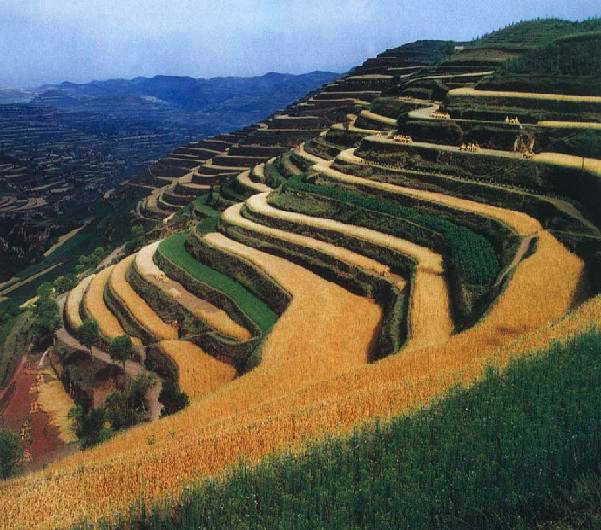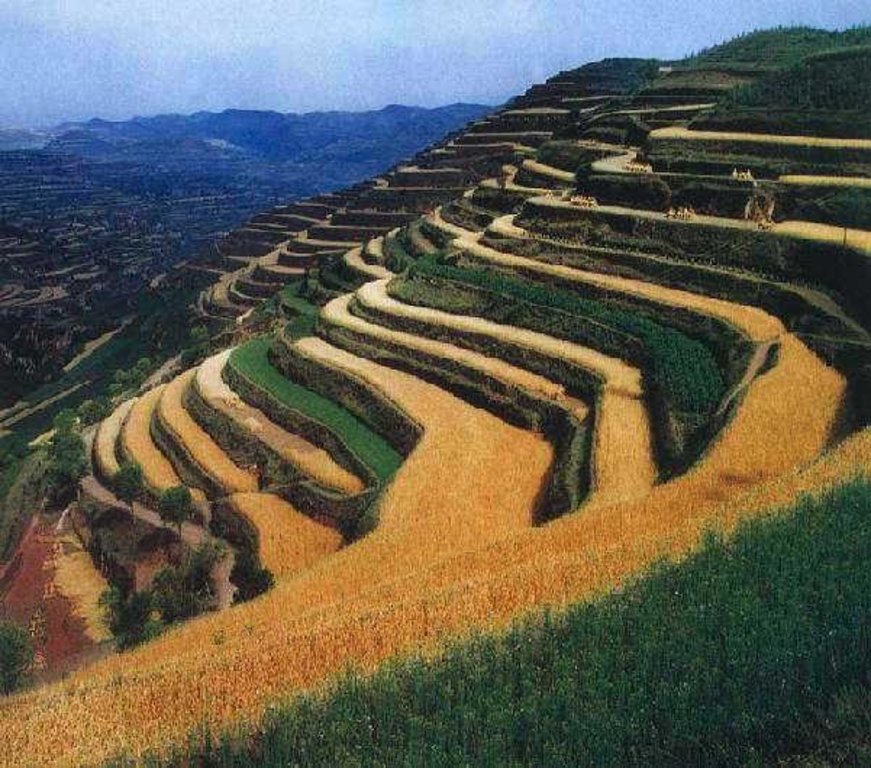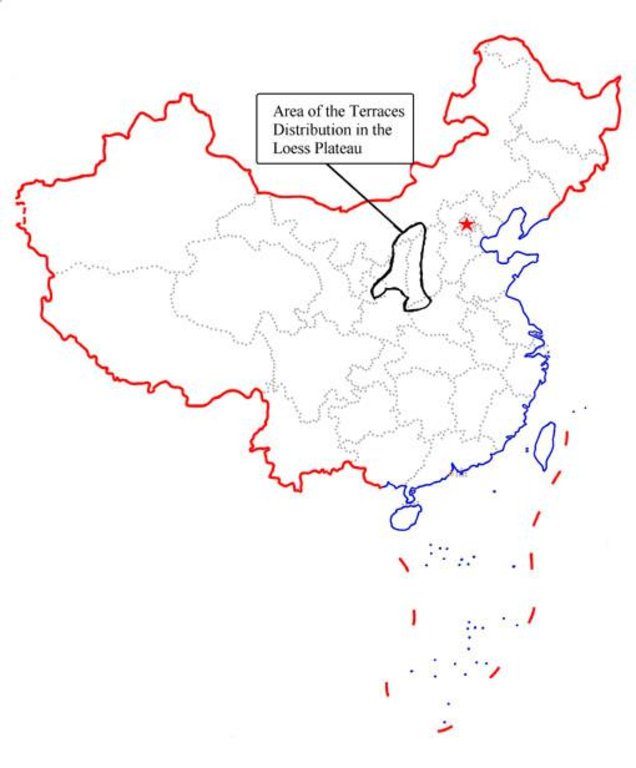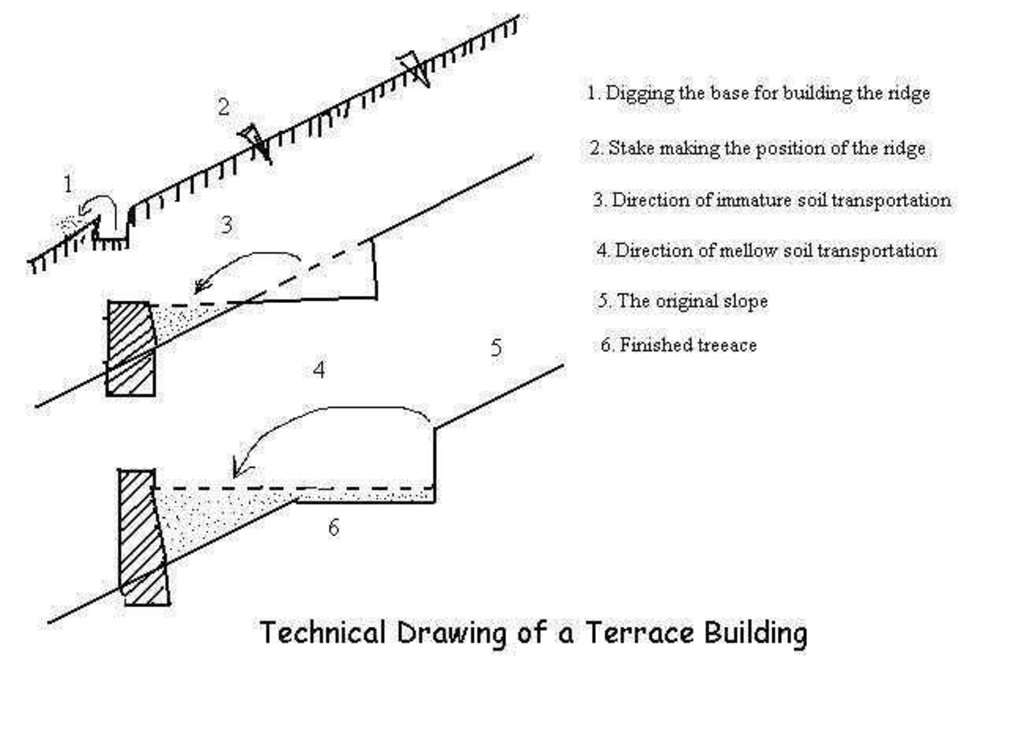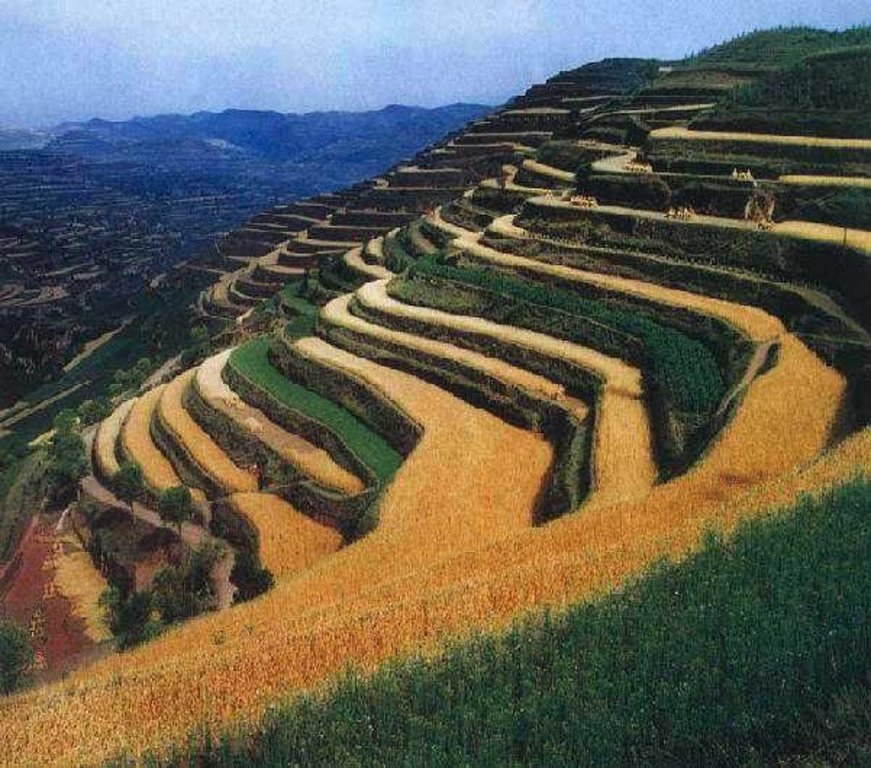Terrace [中国]
- 创建:
- 更新:
- 编制者: Meili WEN
- 编辑者: –
- 审查者: David Streiff
approaches_2394 - 中国
查看章节
全部展开 全部收起1. 一般信息
1.2 参与方法评估和文件编制的资源人员和机构的联系方式
SLM专业人员:
有助于对方法进行记录/评估的机构名称(如相关)
Department of Resources and Environmental Science, Beijing Normal University (Department of Resources and Environmental Science, Beijing Normal University) - 中国1.3 关于使用通过WOCAT记录的数据的条件
编制者和关键资源人员接受有关使用通过WOCAT记录数据的条件。:
是
2. SLM方法的描述
2.1 该方法的简要说明
Terraces are built on a slope land which as a raised bank made up of earth or stone with vertical or sloping sides and an approximately flat top to control soil erosion and preserve and enhance soil fertility.
2.2 该方法的详细说明
该方法的详细说明:
Aims / objectives: A terrace has a raised bank made up of earth or stone with vertical or sloping sides and a flat top. It can reduce slope angle and length, wrap runoff, increase infiltration and reduce soil loss. Crops can grow well because water increases in the soil. The ground cover is improved. Terraces can be constructed by manual labor or machine. Firstly, surveying the slope hills and determining width of terraces according to the slope angle and soil texture. Secondly, leveling up the slope and constructing the banks. Thirdly, maintaining. The terraces are implemented together by state, local A terrace has a raised bank of earth or stone with vertical or sloping sides and a approximately flat top. It can reduce slope angle and length, retain runoff, increase infiltration and reduce the soil loss. Crops can grow well because water increases in soils. Meanwhile, ground cover is improved. Terrace can be constructed by manual labor or machine. Firstly, determining the width of the field according to the slope angle and soil texture. Secondly, putting the topsoil aside. Thirdly, leveling up the slope and constructing banks. At last, putting the topsoil to the top of the flat surface.
2.3 该方法的照片
2.5 采用该方法的国家/地区/地点
国家:
中国
区域/州/省:
Shaanxi, Shanxi, Gansu, Henan, Inner Mongolia
Map
×2.6 该方法的开始和终止日期
注明开始年份:
1950
2.7 方法的类型
- 传统/本土
2.8 该方法的主要目的/目标
The Approach focused mainly on SLM with other activities (Increasing crop yield.)
The main objectives of the approach were conserving soil and water on slope land and enhancing soil fertility.
The SLM Approach addressed the following problems: Soil loss and land degradation, lack of fund and technology.
2.9 推动或妨碍实施本办法所适用的技术的条件
财务资源和服务的可用性/可得性
- 阻碍
No enough money
Treatment through the SLM Approach: The national government partly fund, individual partly invests, local government partly invests.
法律框架(土地使用权、土地和水使用权)
- 阻碍
The existing land ownership, land use rights / water rights hindered a little the approach implementation The ownership of the land resources belongs to state and communities, land users can only lease the land for a period of time, they worry about their land would be transferred to others.
了解SLM,获得技术支持
- 阻碍
Poor knowledge for how to reduce the soil loss
Treatment through the SLM Approach: Ehancing SWC specialists guidance
其他
- 阻碍
Peasant worry about that they can not own the use right.
Treatment through the SLM Approach: The national government advocates whose who invest labors who get the benefits.
3. 相关利益相关者的参与和角色
3.1 该方法涉及的利益相关者及其职责
- 当地土地使用者/当地社区
Working land users were mainly men (Men are the main force for field work.)
Existing groups of land users
Experienced peasant may be involved in introducing the local situations.
Men know much more technical knowledge and skills than women.
If a terrace is constructed by machine, men and women are not different. If a terrace is constructed by manual labor, men can do more work.
- SLM专家/农业顾问
- 国家政府(规划者、决策者)
3.2 当地土地使用者/当地社区参与该方法的不同阶段
| 当地土地使用者/当地社区的参与 | 指定参与人员并描述活动 | |
|---|---|---|
| 启动/动机 | 无 | rapid/participatory rural appraisal; The approach is a traditional way to harvest water and wrap soils, SWC applied land users easy to understand and accept it if some subsidy being obtained. |
| 计划 | 被动 | interviews/questionnaires; Being involved in the planning. |
| 实施 | 自我动员 | responsibility for minor steps; Being involved in the planning. |
| 监测/评估 | 被动 | reporting; No participating. |
| Research | 无 |
3.4 有关SLM技术选择的决策
具体说明谁有权决定选择要实施的技术:
- 主要是SLM专家,咨询土地使用者之后
解释:
consultative.
Decisions on the method of implementing the SLM Technology were made by by politicians / leaders. Generally, land users request. A proposal is prepared by SWC specialists or local government and submitted to leaders for being examined and approved.
4. 技术支持、能力建设和知识管理
4.1 能力建设/培训
是否为土地使用者/其他利益相关者提供培训?:
是
明确受训人员:
- 土地使用者
- extensionists/trainers, politicians/decision makers
培训形式:
- 农民对农民
- 示范区域
- 课程
涵盖的主题:
Teaching them how to design and build terraces on a slope land etc.
4.2 咨询服务
土地使用者有权使用咨询服务吗?:
是
指明是否提供了咨询服务:
- 在土地使用者的土地上
说明/注释:
Local government and SWC division.; Key elements: Demonstration, Visiting, Visiting; 1) Advisory service was carried out through: government's existing extension system 2) Advisory service was carried out through: government's existing extension system; Extension staff: mainly government employees 3) Target groups for extension: land users; Activities: Explain and demonstrate
Advisory service is quite adequate to ensure the continuation of land conservation activities; At each government level, there is a SWC division which is in charge of SWC activities including extension.
4.3 机构强化(组织发展)
是否通过这种方法建立或加强了机构?:
- 是,适度
具体说明机构的强化或建立程度:
- 本地
具体说明支持类型:
- 财务
4.4 监测和评估
监测和评估是该方法的一部分吗?:
是
注释:
bio-physical aspects were regular monitored by 0 through measurements; indicators: None
technical aspects were regular monitored by 0 through measurements; indicators: None
socio-cultural aspects were ad hoc monitored by 0 through observations; indicators: None
economic / production aspects were regular monitored by 0 through measurements; indicators: None
area treated aspects were regular monitored by 0 through measurements; indicators: None
no. of land users involved aspects were ad hoc monitored by 0 through measurements; indicators: None
management of Approach aspects were ad hoc monitored by 0 through observations; indicators: None
There were few changes in the Approach as a result of monitoring and evaluation: None
4.5 研究
研究是该方法的一部分吗?
是
明确话题:
- 经济/市场营销
- 生态学
- 技术
提供进一步的细节,并指出是谁做的研究:
Research was carried out both on station and on-farm
5. 融资和外部物质支持
5.1 该方法中SLM组成部分的年度预算
注释(例如主要的资助来源/主要捐助者):
Approach costs were met by the following donors: government (national - fund): 100.0%
5.2 为土地使用者提供财政/物质支援
土地使用者是否获得实施该技术的财政/物质支持?:
是
5.3 对特定投入的补贴(包括劳动力)
- 设备
| 具体说明哪些投入得到了补贴 | 程度如何 | 对补贴做出具体说明 |
|---|---|---|
| 机械 | 充分融资 | |
| 工具 | 充分融资 | hand tools |
- 农业
| 具体说明哪些投入得到了补贴 | 程度如何 | 对补贴做出具体说明 |
|---|---|---|
| 种子 | 充分融资 | |
| 化肥 | 充分融资 | |
| seedlings and biocides | 充分融资 | |
- 基建
| 具体说明哪些投入得到了补贴 | 程度如何 | 对补贴做出具体说明 |
|---|---|---|
| community infrastructure | 充分融资 | |
如果土地使用者的劳动力是一项重要的投入,那么是不是:
- 以现金支付
注释:
do some work during the construction of the terrace
Labour was also rewarded with other material support
5.4 信用
是否根据SLM活动的方法给予信用值?:
是
对条件(利率、回报等)进行具体说明:
Interest rate charged: 0.5%
Interest was lower than market rate.
6. 影响分析和结论性陈述
6.1 方法的影响
该方法是否帮助土地使用者实施和维护SLM技术?:
- 否
- 是,很少
- 是,中等
- 是,支持力度很大
Subsoiling and applying more manure and compost.
该方法是否改善了阻碍SLM技术实施的土地使用权/用户权问题?:
- 否
- 是,很少
- 是,中等
- 是,支持力度很大
Persuading them to accept The problem is likely to be overcome in the near future. The relationship between land ownership and use rights can be properly dealt with by government and managers.
Did other land users / projects adopt the Approach?
- 否
- 是,很少
- 是,中等
- 是,支持力度很大
According to the local situation, pits and check dam etc. also adopted in the approach.
6.3 方法活动的可持续性
土地使用者能否维持通过该方法实施的措施(无外部支持的情况下)?:
- 否
若否或不确定,请具体说明并予以注释:
no enough money and knowledge
6.4 该方法的长处/优点
| 土地使用者眼中的长处/优势/机会 |
|---|
| increase in production |
| Easier to till |
| 编制者或其他关键资源人员认为的长处/优势/机会 |
|---|
| Reduction of the slope angle (How to sustain/ enhance this strength: Raising terrace bank.) |
| reduction of the slope length (How to sustain/ enhance this strength: Protecting terrace banks by planting trees or others.) |
| Harvest of the runoff and increase in infiltration (How to sustain/ enhance this strength: Protecting the banks) |
| increase in soil fertility and organic matter (How to sustain/ enhance this strength: Applying manure and fertilizer) |
| improvement of ground cover (How to sustain/ enhance this strength: no till with mulching.) |
6.5 该方法的弱点/缺点以及克服它们的方法
| 土地使用者认为的弱点/缺点/风险 | 如何克服它们? |
|---|---|
| Cost much. |
| 编制者或其他关键资源人员认为的弱点/缺点/风险 | 如何克服它们? |
|---|---|
| Decrease in production in the first1-2 year(s) | Fertilizering plenty of manure. |
| The ridge of the terrace is possible to be destroyed by storms and rats | Repairing and maintaining in time. |
7. 参考和链接
7.1 方法/信息来源
- 与土地使用者的访谈
7.2 参考可用出版物
标题、作者、年份、ISBN:
Suide Water and Soil Conservation examination station of Yellow River Water Resources Committee
可以从哪里获得?成本如何?
Corpus of Test Research of Water and Soil Conservation (the second volume), 1981 ,p130~185
标题、作者、年份、ISBN:
Water and Soil Conservation Department of Yellow River Water Resources Committee of Ministry of Water Resources and Electric Power.
可以从哪里获得?成本如何?
Corpus of economic benefits of water and soil measures, 1987, p77~102, 510~514
标题、作者、年份、ISBN:
ongyinglin,Changpiguang ,Wangzhihua. Discussion on the several questions on increasing production of the terrace with two banks.
可以从哪里获得?成本如何?
Soil and Water Conservation Science and Technology in Shanxi, 1990, No.1, p36~37.
标题、作者、年份、ISBN:
Jiangdingsheng. Discussion on section design of the terrace on the Loess Plateau.
可以从哪里获得?成本如何?
ACTA CONSERVATIONIS SOLI ET AQUAE SINICA, 1987,Vol.1,No.2, p28~35
标题、作者、年份、ISBN:
Liangqichun, Changfushuang , Liming. A study on drawing up budgetary estimate quota of terraced field.
可以从哪里获得?成本如何?
Bulletin of Soil and Water Conservation, 2001,Vol.21,No.5, p41~44
标题、作者、年份、ISBN:
Liumingquan, Zhangaiqin, Liyouhua. Pattern engineering of reconstruction the slope cropland.
可以从哪里获得?成本如何?
Soil and Water Conservation Science and Technology in Shanxi, 1992,No.3, p18~21.
标题、作者、年份、ISBN:
Lixuelian,Qiaojiping. Synthetic technology of fertilizing and improving production on the new terrace.
可以从哪里获得?成本如何?
Soil and Water Conservation Science and Technology in Shanxi, 1998,No.3,p13~14.
标题、作者、年份、ISBN:
Terraces in China.
可以从哪里获得?成本如何?
Ministry of Water Resources of China.The press of Jilin science technology , 1989
链接和模块
全部展开 全部收起链接
无链接
模块
无模块


